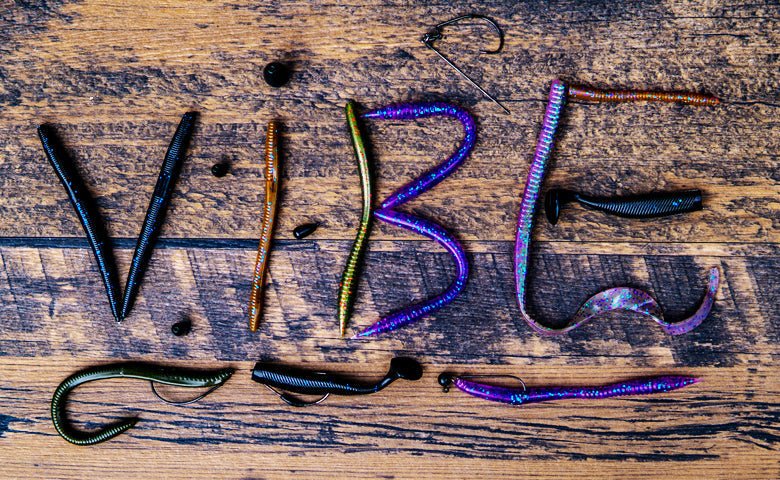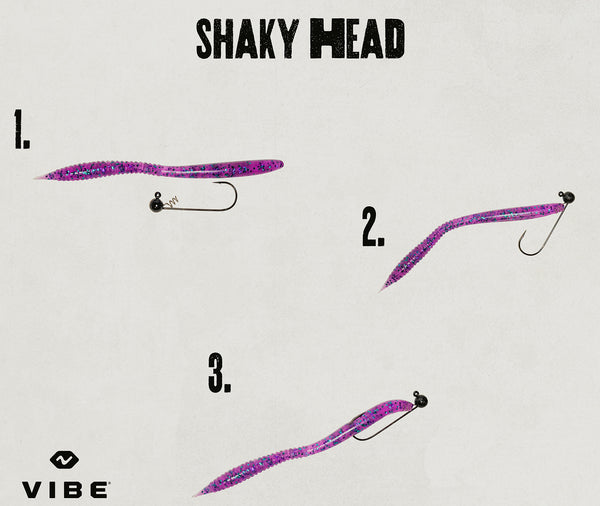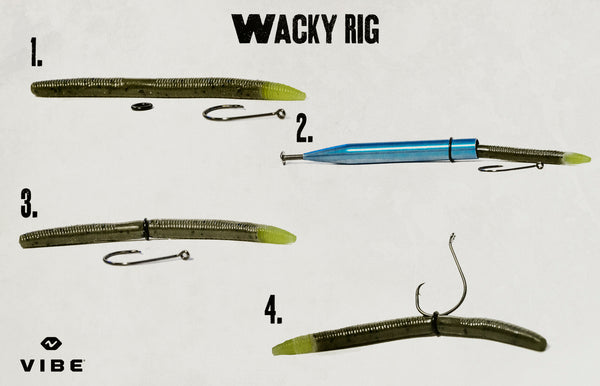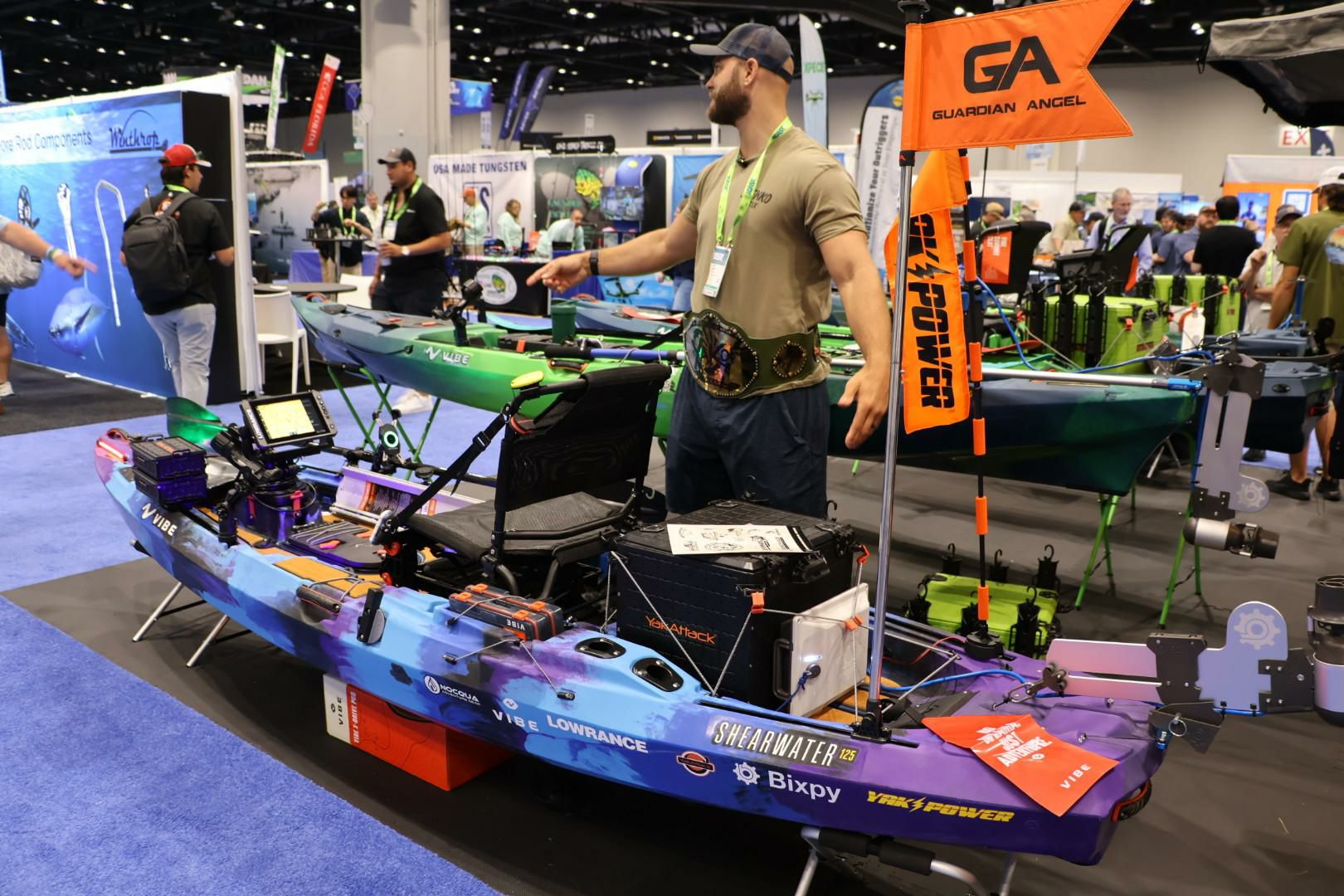Bass Fishing 202: (Lures, Rigs & Baits)

We already talked about lures, now it’s time to talk about rigs, simply put a rig is the way you utilize your hook, weight, and line to present a lure (or bait) to the fish in the most realistic way possible. There are hundreds of configurations for rigging plastics, we will cover some of the popular ones that kayak bass fishing anglers utilize to catch mondo bass. These methods are tried and true, some have been around for as long as tournament bass fishing has been around, some are new kids on the block that are changing the way we approach finesse fishing entirely. But one thing they all have in common is that they all catch fish.
Texas Rig: Your grandfather likely fished with a Texas Rig; it has been one of the most common ways to rig a lure for about as long as artificial lures have been used. It can be very versatile it is commonly rigged weightless, weighted, and weedless. And can be fished across the top, bounced off the bottom, or through the thick grass and weeds. The slim profile allows it to be fished through and around cover, and the falling action gives bass something to clue in on.
How to rig it: with a 3/0 or 4/0 straight shank hook and a soft plastic bait of your choosing.

- Insert the point of the hook into the tip of the bait
- Bring the point out of the bottom of the bait ¼” from the tip
- Pull the hook through the tip of the bait until the eye of the hook rests just inside the tip.
- Twist the hook so that the point is facing back toward the bait.
- lay the hook next to the plastic and mark the furthest point on the bait that the hook reaches
- compress the bait and insert the hook into your marked point.
- Push the hook through pulling the bait parallel with the point of the hook
- (Optional) nest the tip back into the bait just barely, this makes it “weedless”
When to fish it: Many kayak bass fishermen will have one tied on no matter the conditions. This is one of those baits that can work in any water, any conditions, and any time of the year. Just be mindful of the way you want to present it, and the speed with which you reel it in.
How to fish it: Texas rigs can be fished so many ways, from using a finesse worm, a 10” bull worm and everything in between the only limitation is your imagination. If you are fishing it weighted, fish it off the bottom, let it sink down and either drag or hop it across the bottom trying to imitate the creature you have tied on. If you are fishing it weightless or with a small weight and have a swimming style lure tied on swim it through the middle of the water column varying your retrieve. If it is rigged up weedless feel free to toss it in the thick cover where bass might be holding, around structure, wherever and drag or hop it back out. I have even had good luck ripping a Texas rigged ribbon tail quickly across the surface of the water when its thick.
Shaky head: The shaky head is a tough conditions bait, when you are in that kayak bass fishing tournament and you need to put 2 more fish of any size on the board, it might be time to give the shaky head a try. It is a jigging technique that uses specialized jig head hooks. Some people will say you wont catch big fish on a shaky head, but most will not dispute that you will put fish in the boat, and sometimes in a kayak tournament that is the key to success.
How to rig it: Get yourself some shaky head jig hooks in the appropriate size for your lure. Usually, you would use some sort of tapered worm or even a long creature bait with some pincers to insert some action into the technique.

- Screw the head of the lure into the keeper on the end of your shaky head jig hook.
- Mark the end of the bend in the hook, and insert the point at that spot
- If necessary reinsert the tip of the hook lightly back into the bait to present it weedless.
A note on rigging shaky heads, this is a finesse technique so lighter line is ideal, 8-12lb fluorocarbon line would be ideal here.
When to fish it: The shaky head is a year-round technique but many people will call it a cold water, clear water technique. Any time the bass are up shallow whether they are cruising and feeding, or they are protecting fry, a shaky head tossed in front of them will be a tasty morsel that they can’t ignore.
How To fish it: You would think with a name like “shaky head” that you are going to get tired from shaking this thing to impart action. But that is really not the way it is fished.
Dragging it: When the water is cold, and bass are not biting, dragging a shaky head across the bottom without imparting much action is going to produce results when almost nothing else will.
Hopping it: Anytime you are fishing a craw imitation this is the way to fish it, bass key in to sounds and vibrations and crawfish make a very distinct sound when they are skimming across the bottom, hopping a shaky head with a creature or craw lure on it will imitate this sound and profile, and will attract bass even when they aren’t really biting.
Wacky Rig: The wacky rig is just that, a bit unique. When you first look at it, you will wonder if the person rigging it up is pulling your leg. But after fishing it for a short time you will become a believer. It is not inherently a weedless design like others we have discussed, but it can still be fished around some weeds and cover due to the weightless nature of it, and the slow speed in which it is retrieved.
How to rig it: Using a short shank wide gap hook (or a wacky specific variant) and an O-ring will provide the best results. Tie it on with 10-15lb fluorocarbon. Your lure should usually be some variant of a salted “finesse” worm, or a senko, with the senko being the top choice for most people.

- Using a wacky rig tool is the easiest way to get an O-ring onto a soft plastic, just wet the tool, and slide an O-ring down the tube and onto the lure at the halfway mark on the lure.
- Slide your hook under the O-ring not piercing the lure
- It is that easy.
When to fish it: I know kayak bass tournament anglers who ALWAYS have one tied on, this is a tactic that can be used any time of year, in most conditions and certainly any time the fish are shallow (1-12 ft)
How to fish it: This is certainly a presentation that benefits from a good soak, which is to say, let it settle for a bit before doing anything. It is fished weightless so you are relying on the salt in the bait to sink it, sometimes fish will gulp it up as it falls, but more often than not you need to wait for it to sink down before giving it a slight twitch and reeling in your slack a little repeating this twitch, reel, pause, cadence through the strike zone. This is not a presentation that you usually fish all the way back to the boat, usually you are just targeting a strike zone with it, and reeling in to re-cast if you don’t produce a bite within 10 feet or so. Skip it under docks, around structure like logs and stumps, and right against weed lines, and you will see results.
Dropshot: Often considered a “Northern technique” this is a finesse fishing technique that will help you catch pressured bass anywhere, not just the clear deep cold water of the north. The dropshot rig excels anytime fish are suspended or out deep as well as any time they are pressured and will only bite the most subtle of presentations.
How to rig it: Using a #4 hook you are going to need light (6-10lb) fluorocarbon line, a 1/8 oz-1/2 oz drop shot weight, and a bit of patience for experimenting with what works for you.

- Tie a Palomar knot leaving a long tag line long as in anywhere from 12”-36”
- Tie on or clip your weight to the bottom of the tag line (tie it so you don’t lose it when the fish jumps)
- Nose hook your favorite finesse worm
When to fish it: If you look down at your graph and see fish schooled up deep below you, but you cant seem to get them to bite on a jig, jerkbait, or deep diving crankbait. Maybe give the dropshot a try, as it falls the lure will flutter down above the weight. Any time you are in cold clear water and you see fish held to deep structure. Or any time you are fishing for smallmouth bass in the spring or late fall.
How to fish it: The dropshot take a little getting used to, on the user end it feels different than many baits due to the light line and the way you are playing it suspended off the bottom. You can fish it vertically for suspended fish by just bouncing it lightly up through the column and letting it sink again, or you can fish it off the bottom just lightly bouncing it over and through structure keeping that weight in close contact with the bottom. This is one more “this will put fish in your boat when nothing else will” technique that too many people ignore on pressured lakes.
Swimbaits: This is less of a rig and more of a style of hook designed for a bait. But it deserves mention because a belly weighted swimbait hook is the best way to fish a paddle tail swimbait if you are looking for a more finesse look than you get with a swim jig, which was discussed in our previous article. This is a year-round technique that can produce big bass in tough conditions.
How to rig it: This one is pretty easy, with the appropriately sized swimbait hook (belly weighted or jighead) tie it on to 12-15lb fluorocarbon. And rig it as straight as possible as follows:

All baits shown are from Dirigo Baits.
1. With a jig head or pin lock hook, you will simply hook through the nose coming out the back (paddle tail faces down.
2. With a screw-lock belly weighted hook you screw in the nose. Marking on the bait the length of the point and piercing it at that point.
When to fish it: Swim it through the water column any time of year bass are prowling, spring, summer, fall, if you swim a realistic swimbait in front of a hungry bass they are not going to turn it down.
How to fish it: Belly weighted swim baits might require some tuning to get the action exactly how you like it, most of the time the weight can be shifted on the hook to change the way the bait reacts. But this is one of those cast it out and fish it back in around points, let it fall and pull it just over structure or grass, add some darting movements by varying your retrieve and hold on because big bass will make a quick snack of a swimbait!
This list is far from a complete guide to rigging baits for tournament bass fishing, but it should give you an idea of a handful of popular and useful techniques that are tried and true ways to help you climb the leaderboards in your event. Experiment a little with different lures and weights, make it a fun game of trying to key in on specifics with each of these rigs and you will learn a lot about a body of water. As always have fun out there and be safe. Check back for our next article about popular baits for kayak fishermen.
Tune In Next time when we talk about Baits!
No Drama. Just Adventure.



